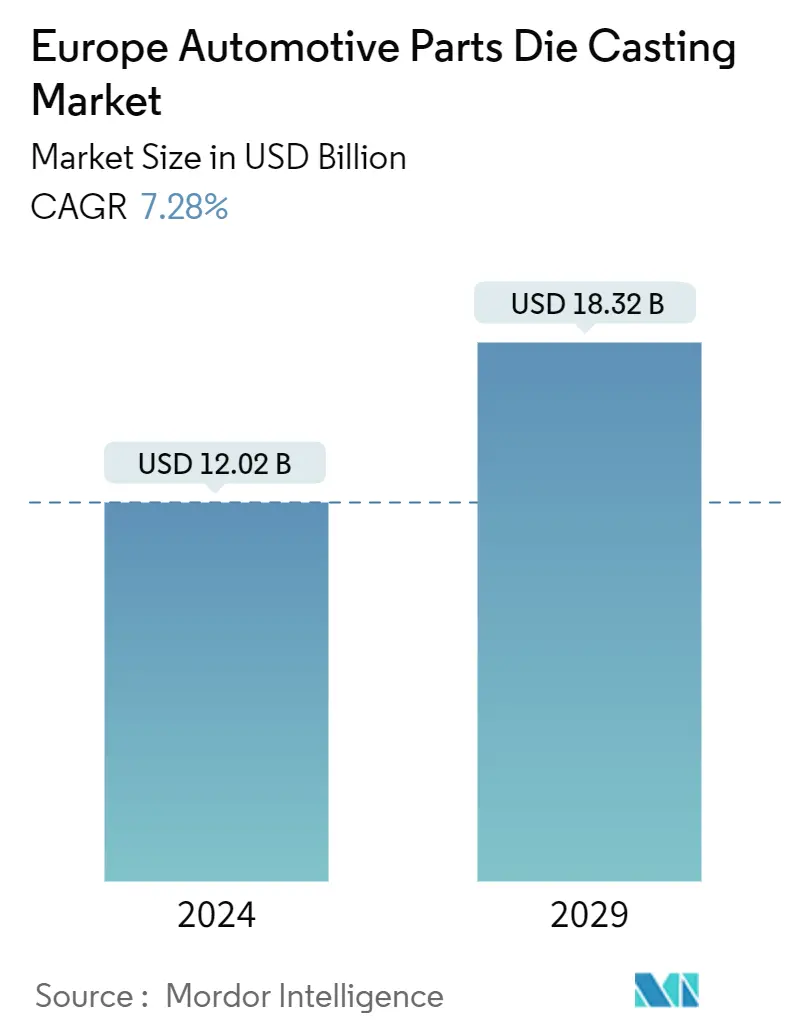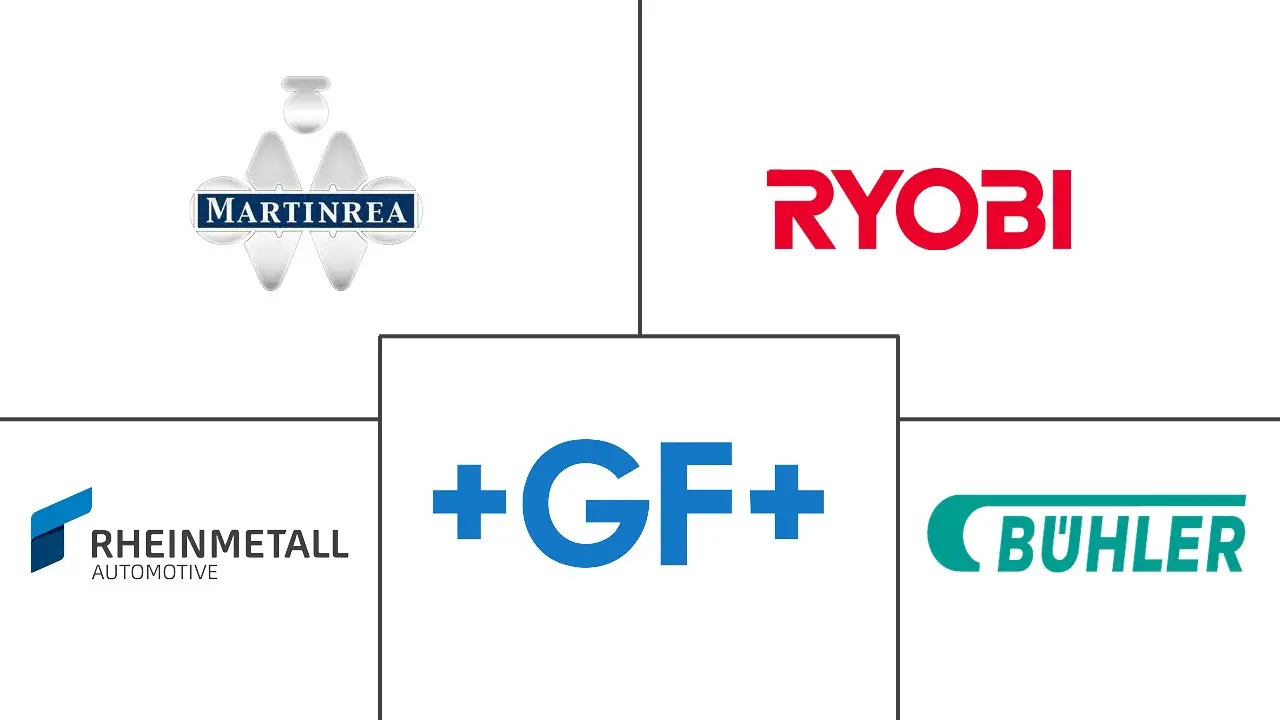Market Size of Europe Automotive Parts Die Casting Industry

| Study Period | 2019 - 2029 |
| Base Year For Estimation | 2023 |
| Market Size (2024) | USD 12.02 Billion |
| Market Size (2029) | USD 18.32 Billion |
| CAGR (2024 - 2029) | 7.28 % |
| Market Concentration | Low |
Major Players
*Disclaimer: Major Players sorted in no particular order |
Europe Automotive Parts Die Casting Market Analysis
The Europe Automotive Parts Die Casting Market size is estimated at USD 12.02 billion in 2024, and is expected to reach USD 18.32 billion by 2029, growing at a CAGR of 7.28% during the forecast period (2024-2029).
- The COVID-19 pandemic severely impacted the automotive industry across the world. The disruptions in supply chain activities, the interruption in large-scale manufacturing, restrictions on travel, and the declining sales of vehicles during 2020 were responsible for the declining growth of the market. However, after the pandemic, a surge in the manufacturing volume of passenger cars and hybrid electric vehicles was observed in the country due to the easing of restrictions. The automotive parts die-casting market in Europe coped with all the losses that happened during the period and grew at a certain pace.
- Over the long term, the market studied is largely driven by supply chain complexities in the die-casting industry, expanding the automotive market, increasing penetration of die-casting parts in industrial machinery, growing commercial vehicle sector, and employing aluminum casts in electrical and electronics.
- The European industry, as a whole, has more than doubled the average amount of die-cast parts that have been used in passenger cars for the past 20 years. From just 50 kg of aluminum parts per passenger vehicle in 1990 to over 500 kg of it in the AUDI A8 model, the market for automotive parts die casting is evolving in the region and is expected to maintain moderate growth for the coming five years.
- Non-ferrous castings in Europe registered an average performance of 37 metric tons per employee in 2021, according to the latest statistics from the European Foundry Association (EFA). Over 80% of the castings produced in Europe are consumed by the automotive industry.
- The Corporate Average Fuel Economy (CAFÉ) standards and Environmental Protection Agency (EPA) policies to cut down automobile emissions and increase fuel efficiency are driving the automakers to reduce the weight of the automobile by employing lightweight non-ferrous metals. Demand from the commercial vehicle segment is one other factor that is driving the market. On the flip side, the shift toward electric vehicles is expected to act as a major restraint on the casting industry. A combustion engine contains approximately 220 casted parts, but only about 25 are needed for an electrical drive. Also, the number of people employed in European non-ferrous casting foundries has been volatile for the past five years.
Europe Automotive Parts Die Casting Industry Segmentation
Automotive die casting uses a metal molding process to produce parts from molten metal (die). They then cool the metal and solidify it into machined items such as engine blocks or gearboxes. This approach eliminates waste while saving manufacturers and customers time and money.
The Europe automotive parts die casting market has been segmented by production process type (vacuum die casting, pressure die casting, and other production process types), application type (engine parts, transmission components, structural parts, and other application types), metal type (aluminum, zinc, and other metal types), and country (Germany, United Kingdom, France, Italy, Rest of Europe).
The report offers the market size in value (USD) and forecasts for all the above segments.
| By Production Process Type | |
| Vacuum Die Casting | |
| Pressure Die Casting | |
| Other Production Process Types |
| By Metal Type | |
| Aluminum | |
| Zinc | |
| Other Metal Types |
| By Application Type | |
| Engine Parts | |
| Transmission Components | |
| Structural Parts | |
| Other Application Types |
| Geography | ||||||||
|
Europe Automotive Parts Die Casting Market Size Summary
The European automotive parts die casting market is poised for significant growth over the forecast period, driven by the recovery from pandemic-induced disruptions and the increasing demand for lightweight vehicle components. The market is benefiting from the expanding automotive sector, particularly in passenger cars and hybrid electric vehicles, as well as the growing commercial vehicle segment. The shift towards using aluminum casts in electrical and electronics is also contributing to market expansion. The European industry has seen a substantial increase in the use of die-cast parts in passenger vehicles, with a notable rise in the average weight of aluminum components per vehicle. This trend is supported by regulatory pressures to reduce vehicle weight and improve fuel efficiency, aligning with environmental standards.
Germany and the United Kingdom are expected to lead the market, with Germany being a major hub due to its robust automotive manufacturing base and significant investments in research and development. The presence of leading automobile and component manufacturers in these countries is a key driver of market growth. The market is characterized by a fragmented landscape with major players like Rheinmetall AG, GF Automotive, and Martinrea investing in advanced production processes and alloys to meet the demands of the automotive and industrial sectors. Despite challenges posed by the shift towards electric vehicles, the market is anticipated to maintain a positive growth trajectory, supported by innovations in die-casting technologies and the increasing preference for light commercial vehicles in logistics.
Europe Automotive Parts Die Casting Market Size - Table of Contents
-
1. MARKET DYNAMICS
-
1.1 Market Drivers
-
1.1.1 Growing Use of Aluminum in Die Casting Equipment to Increase Market Demand
-
-
1.2 Market Restraints
-
1.2.1 Fluctuations in Raw Material Prices
-
-
1.3 Industry Attractiveness - Porter's Five Forces Analysis
-
1.3.1 Threat of New Entrants
-
1.3.2 Bargaining Power of Buyers/Consumers
-
1.3.3 Bargaining Power of Suppliers
-
1.3.4 Threat of Substitute Products
-
1.3.5 Intensity of Competitive Rivalry
-
-
-
2. MARKET SEGMENTATION ( Value in USD Billion)
-
2.1 By Production Process Type
-
2.1.1 Vacuum Die Casting
-
2.1.2 Pressure Die Casting
-
2.1.3 Other Production Process Types
-
-
2.2 By Metal Type
-
2.2.1 Aluminum
-
2.2.2 Zinc
-
2.2.3 Other Metal Types
-
-
2.3 By Application Type
-
2.3.1 Engine Parts
-
2.3.2 Transmission Components
-
2.3.3 Structural Parts
-
2.3.4 Other Application Types
-
-
2.4 Geography
-
2.4.1 Europe
-
2.4.1.1 Germany
-
2.4.1.2 United Kingdom
-
2.4.1.3 France
-
2.4.1.4 Italy
-
2.4.1.5 Russia
-
2.4.1.6 Rest of Europe
-
-
-
Europe Automotive Parts Die Casting Market Size FAQs
How big is the Europe Automotive Parts Die Casting Market?
The Europe Automotive Parts Die Casting Market size is expected to reach USD 12.02 billion in 2024 and grow at a CAGR of 7.28% to reach USD 18.32 billion by 2029.
What is the current Europe Automotive Parts Die Casting Market size?
In 2024, the Europe Automotive Parts Die Casting Market size is expected to reach USD 12.02 billion.

